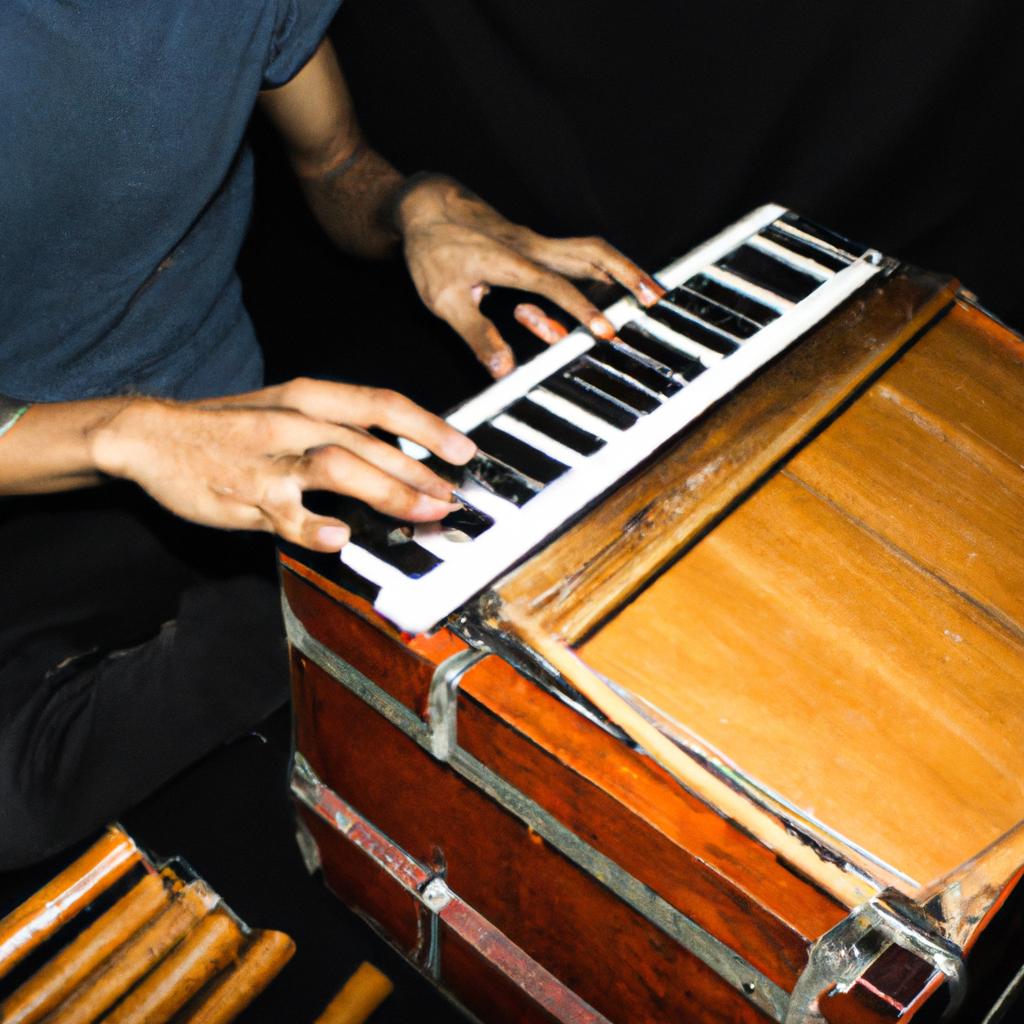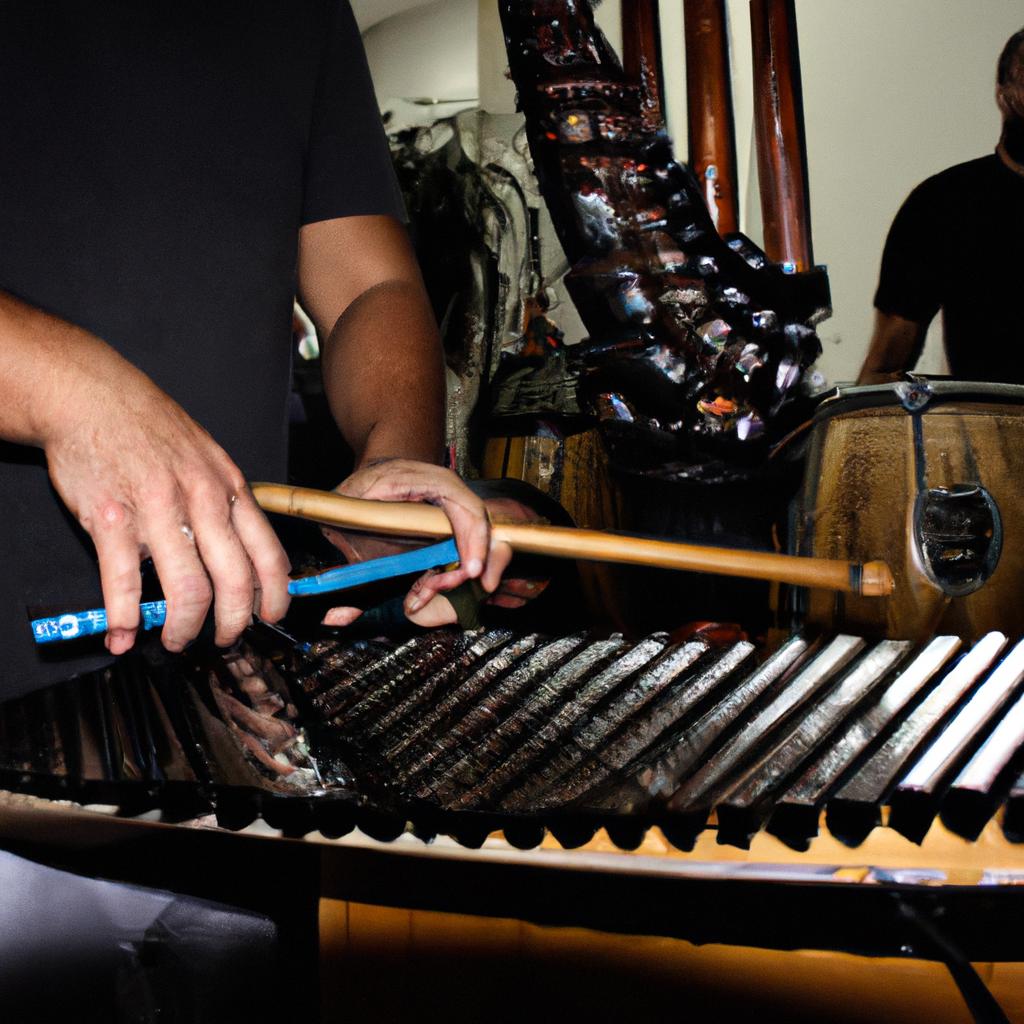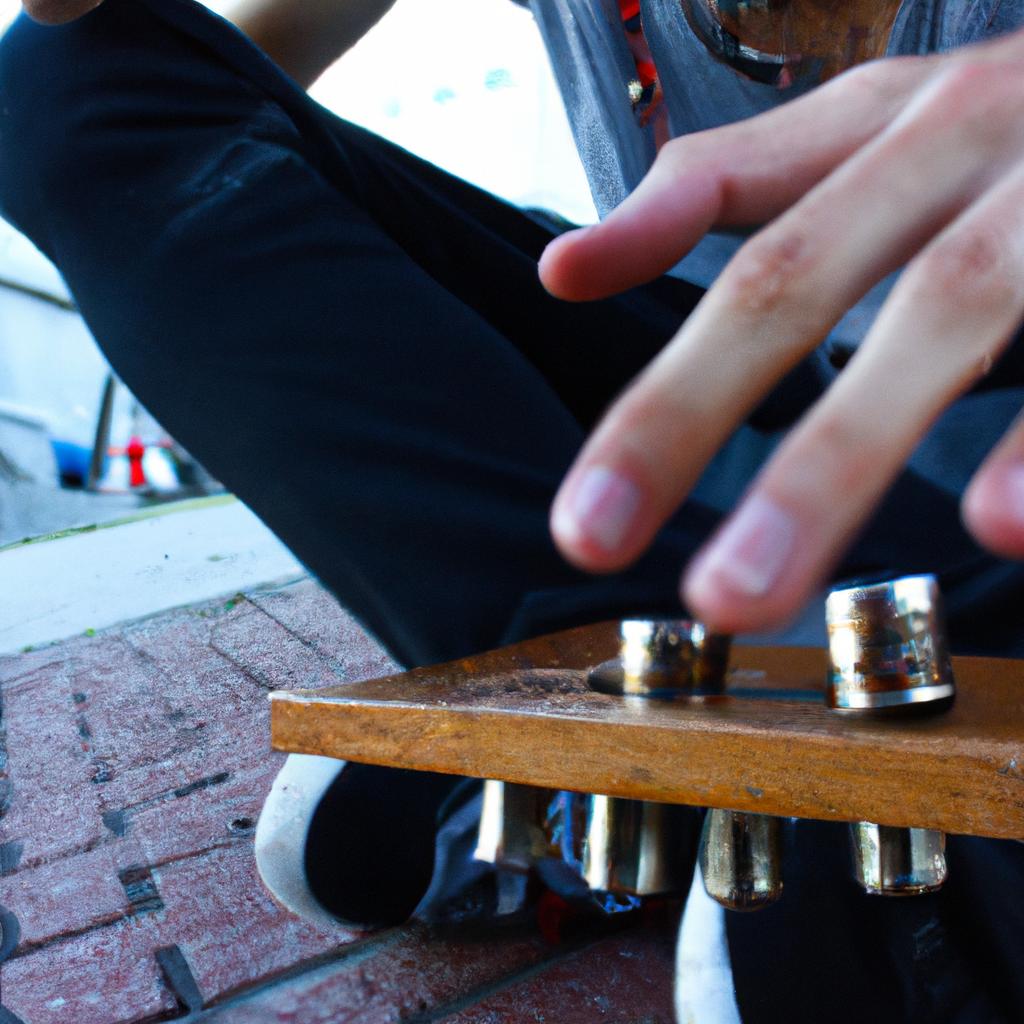Instruments in Arts and Entertainment: A Musical Overview

In the realm of arts and entertainment, musical instruments play a significant role in shaping the sonic landscape that accompanies various forms of creative expression. From orchestras to rock bands, solo performers to ensembles, the diversity and versatility of these instruments enable artists to craft unique melodies, harmonies, and rhythms that captivate audiences worldwide. This article provides an academic overview of instruments in arts and entertainment, exploring their historical significance, cultural influence, and technical intricacies.
To illustrate the profound impact of musical instruments on artistic endeavors, let us consider a hypothetical scenario involving a renowned pianist embarking on a world tour. As this virtuoso musician takes center stage before a hushed audience eagerly awaiting the first notes to resonate from the grand piano’s strings, one cannot help but marvel at the instrument’s ability to convey emotion and transport listeners through its rich timbre. The intricate movements of the pianist’s fingers over the ivory keys evoke feelings of melancholy or joy depending on the composition being played. In this case study-like example, it becomes apparent how instrumental choices can profoundly shape not only individual performances but also entire artistic experiences.
History of Instruments
Imagine a world without music. No melodies to lift our spirits, no harmonies to touch our souls. It is difficult to fathom such a reality when instruments have been an integral part of human culture for thousands of years. From ancient civilizations to modern times, the history of instruments reveals the remarkable evolution and diversity in musical expression.
One fascinating example that highlights the significance of instruments in shaping cultural identity is the traditional Chinese instrument called the guqin. Dating back over 3,000 years, this seven-stringed zither has played a pivotal role in Chinese literature, painting, and philosophy. Its delicate tones evoke deep emotions and are said to reflect the essence of nature itself.
Throughout history, instruments have served various purposes beyond mere entertainment or artistic expression. They have often been employed as tools for communication, religious rituals, and social gatherings. To illustrate this, consider four key ways in which instruments have influenced human experiences:
- Emotional connection: Music transcends language barriers and connects people on an emotional level like nothing else can.
- Cultural preservation: Instruments preserve cultural heritage by passing down traditions from one generation to another.
- Personal expression: Playing an instrument allows individuals to express their unique thoughts, feelings, and experiences through sound.
- Community cohesion: Shared musical experiences foster a sense of belonging within communities and create lasting bonds among individuals.
To further grasp the breadth and depth of instruments’ impact throughout history, let us explore a brief overview through a table showcasing different types across cultures:
| Instrument | Cultural Origins | Main Features |
|---|---|---|
| Sitar | India | Stringed instrument with resonating strings and movable frets |
| Djembe | West Africa | Hand drum with goatskin head |
| Bagpipes | Scotland | Wind instrument with reeds |
| Erhu | China | Two-stringed bowed instrument |
As we delve into the fascinating world of instruments, it becomes evident that their significance goes far beyond mere entertainment. Instruments have shaped cultures, connected people on an emotional level, and provided a means for personal expression throughout history.
Transitioning seamlessly to our next section about “Different Types of Instruments,” we will explore the diverse range of instruments found across various musical genres and traditions.
Different Types of Instruments
Instruments in Arts and Entertainment: A Musical Overview
Having explored the history of instruments, let us now delve into the different types that have shaped the landscape of arts and entertainment. To illustrate this diversity, consider a hypothetical scenario where an aspiring musician is contemplating which instrument to learn. The options available are numerous, each with its own unique characteristics and potential for artistic expression.
In understanding the vast array of musical instruments, it is helpful to categorize them based on their primary mode of sound production. This classification can be broadly divided into four categories:
-
String Instruments:
- Examples include the violin, guitar, and harp.
- They produce sound through vibrating strings that are either plucked, bowed or struck.
-
Wind Instruments:
- Examples include the flute, saxophone, and trumpet.
- Sound is created by blowing air into or across a mouthpiece or reed mechanism.
-
Percussion Instruments:
- Examples include drums, cymbals, and xylophones.
- These instruments create sound when struck or shaken.
-
Keyboard Instruments:
- Examples include the piano, organ, and synthesizer.
- Sound is produced when keys are pressed down to strike strings (in pianos) or trigger electronic sounds (in synthesizers).
To further emphasize the rich variety within these instrument categories, below is a table highlighting some popular examples from each group:
| Category | Example |
|---|---|
| String Instruments | Violin |
| Guitar | |
| Harp | |
| ——————- | ——————— |
| Wind Instruments | Flute |
| Saxophone | |
| Trumpet | |
| ——————- | ——————— |
| Percussion | Drums |
| Instruments | Cymbals |
| Xylophone | |
| ——————- | ——————— |
| Keyboard | Piano |
| Instruments | Organ |
| Synthesizer |
This variety of instruments, with their distinct sounds and playing techniques, allows musicians to create a rich tapestry of musical expressions. From the soaring melodies of violins to the rhythmic beats of drums, each instrument brings its own unique flavor to an ensemble or solo performance.
In our next section on the role of instruments in performance, we will explore how these diverse instruments come together to create captivating musical experiences. With this understanding of instrument types and their capabilities, we can appreciate the intricate interplay between performers and their chosen tools as they bring artistry to life on stage.
Role of Instruments in Performance
Section Title: The Influence of Different Types of Instruments
Building upon our understanding of the various types of instruments, let us now explore how these instruments play a vital role in enhancing performances and shaping the overall experience for both artists and audiences.
Instruments serve as powerful tools that help musicians convey emotions, create unique soundscapes, and captivate listeners. For instance, imagine a pianist sitting at a grand piano on a dimly lit stage. As they delicately press the keys, their fingers glide effortlessly to produce a beautifully haunting melody. This captivating performance showcases the ability of instruments to evoke deep emotions within us.
To fully appreciate the impact of different instruments in arts and entertainment, consider the following aspects:
-
Range of Sounds: Each instrument possesses its own distinctive timbre, pitch range, and expressive capabilities. From the warm tones of a cello to the piercing notes of an electric guitar, this diversity allows artists to create contrasting textures that enrich compositions.
-
Cultural Significance: Instruments often carry historical and cultural significance within specific communities or regions. They can reflect societal values or traditions while bridging gaps between generations. For example:
- In Irish folk music, traditional instruments like the tin whistle and bodhrán showcase national pride.
- The sitar is deeply rooted in Indian classical music and represents centuries-old heritage.
-
Technical Complexity: Some instruments require years of practice to master due to their intricate techniques or physical demands. Learning such instruments not only develops technical proficiency but also instills discipline and patience in aspiring musicians who embark on this challenging journey.
-
Collaborative Possibilities: Combining multiple instruments creates opportunities for collaboration among artists from different backgrounds or genres. By merging diverse musical styles into harmonious arrangements, musicians can push boundaries and create innovative works that resonate with audiences worldwide.
| Instrument | Sound Characteristics | Cultural Significance |
|---|---|---|
| Violin | Expressive, melodic, and versatile | Classical and folk traditions |
| Saxophone | Smooth, soulful, and dynamic | Jazz and popular music |
| Tabla | Rhythmic, percussive, and vibrant | Indian classical music |
| Electric Guitar | Distorted, powerful, and energetic | Rock and heavy metal |
In conclusion,
Now that we have explored the influence of different types of instruments in arts and entertainment let us delve into the world of famous instrumentalists.
Famous Instrumentalists
Transitioning from the role of instruments in performance, we now turn our attention to the notable instrumentalists who have made significant contributions to the world of music. One such example is Ludwig van Beethoven, a renowned composer and pianist whose compositions revolutionized classical music. His mastery of the piano allowed him to express his emotions and ideas through intricate melodies and harmonies.
Instrumentalists play a vital role in bringing musical compositions to life. They possess exceptional technical skills and interpretive abilities that enable them to convey the intended message behind each piece they perform. Here are some key aspects highlighting their importance:
-
Expressiveness: Instrumentalists have an incredible capacity for emotional expression through their chosen instrument. Whether it’s the soulful sound of a saxophone or the delicate plucking of a violin, these musicians can evoke powerful emotions within listeners.
-
Creativity: Instrumentalists often showcase their creativity by improvising or creating unique arrangements of existing compositions. Their ability to think outside the box adds freshness and innovation to traditional pieces, captivating audiences with unexpected interpretations.
-
Collaboration: Many instrumentalists frequently collaborate with other musicians, forming ensembles or joining orchestras, bands, or chamber groups. This collaboration fosters teamwork, as performers must listen attentively to one another while synchronizing their playing styles for a cohesive performance.
-
Cultural Preservation: Through their dedication to mastering various instruments, instrumentalists help preserve cultural traditions and heritage. By learning and performing music from different regions around the world, they contribute to the preservation of diverse musical genres and ensure their longevity.
In addition to recognizing individual instrumentalists’ remarkable talents, it is worth exploring how various instruments differ in terms of characteristics such as range, timbre (tone color), and technique required for playing them effectively. The table below provides an overview of three common types of instruments:
| Instrument | Range | Timbre | Technique |
|---|---|---|---|
| Piano | Broad range | Resonant and versatile | Requires simultaneous use of |
| both hands | |||
| Violin | Wide pitch range | Warm and expressive | Involves bowing or plucking |
| strings | |||
| Trumpet | Limited range | Bright and powerful | Utilizes valves to change |
| pitches |
Understanding the distinct qualities of various instruments allows musicians to make informed choices when selecting a particular instrument for their musical endeavors. Moreover, this knowledge enables composers to compose music that best utilizes the unique characteristics of each instrument.
As we delve deeper into our exploration of instruments in arts and entertainment, it becomes evident that instrumentalists play an indispensable role in shaping the world of music. Their expressiveness, creativity, collaboration, and contribution to cultural preservation all contribute to the richness and diversity of musical experiences. Now let us shift gears and explore another crucial aspect: instrument maintenance and care.
Instrument Maintenance and Care
Transitioning from the previous section, where we explored the lives of famous instrumentalists and their contributions to the world of music, it is important to delve into a topic that often goes unnoticed but plays a vital role in ensuring the longevity and quality of musical instruments: maintenance and care. To illustrate this point, let’s consider the case study of renowned violinist Clara Thompson, who struggled with issues stemming from neglecting her instrument.
Clara Thompson was an extraordinarily talented violinist whose performances captivated audiences worldwide. However, due to her demanding schedule and lack of attention towards maintaining her instrument, she encountered numerous setbacks during an important concert tour. The strings on her beloved violin snapped just moments before going out on stage, leaving her distraught and unable to perform at her best. This unfortunate incident could have been prevented through regular maintenance practices.
Proper maintenance not only ensures optimal sound production but also extends the lifespan of musical instruments. Here are some key aspects musicians should consider when caring for their cherished tools:
- Regular cleaning: Dust and grime can accumulate on the surface of an instrument over time, affecting both its appearance and sound quality. Cleaning instruments with appropriate materials helps preserve their overall condition.
- Climate control: Extreme temperature or humidity fluctuations can cause significant damage to delicate wooden components present in many stringed instruments. Maintaining stable environmental conditions through proper storage is crucial.
- String replacement: Strings naturally wear down due to continuous use, resulting in diminished tone quality. Replacing them regularly enhances playability and prevents sudden breakage.
- Professional check-ups: Just like any other valuable asset, musical instruments benefit from periodic inspections by qualified technicians. These professionals can identify potential problems early on and conduct necessary repairs or adjustments.
To further emphasize the importance of instrument care, here is a table showcasing common issues faced by neglected instruments, along with corresponding consequences:
| Issue | Consequence |
|---|---|
| Lack of cleaning | Reduced sound quality and potential damage |
| Improper storage | Warping, cracking, or structural instability |
| Neglected string replacement | Dull tone and increased risk of strings breaking |
| Ignoring necessary repairs | Intensified issues requiring more extensive fixes |
In conclusion, maintaining musical instruments is an essential responsibility for artists committed to producing exceptional performances. By incorporating regular cleaning routines, controlling the instrument’s environment, replacing worn-out components promptly, and seeking professional expertise when needed, musicians can ensure their instruments remain in optimal condition throughout their careers.
Transitioning into our next section on “Instruments in Popular Culture,” we will explore how various musical tools have become iconic symbols within different forms of artistic expression.
Instruments in Popular Culture
Transitioning from the previous section on instrument maintenance and care, it is evident that instruments go beyond their functional use within artistic endeavours. They have also made a profound impact on popular culture, influencing various aspects of society including music, film, fashion, and even social movements. To illustrate this point, let us consider the case study of the electric guitar.
The electric guitar has become synonymous with rock music and rebellion. One can hardly discuss popular culture without mentioning iconic figures like Jimi Hendrix or Jimmy Page wielding their guitars on stage, mesmerizing audiences with both their musical prowess and charismatic presence. The rise of rock ‘n’ roll in the 1950s propelled the electric guitar into the limelight, transforming it from a mere instrument to an emblem of youth counterculture and self-expression.
To fully grasp the significant role instruments play in shaping popular culture, here are some key examples:
- Music industry: Instruments have been integral to defining different genres of music throughout history. From jazz saxophones to hip-hop turntables, each genre carries its own distinctive sound created by specific instruments.
- Fashion trends: Musical instruments often inspire fashion choices as well. Think about how leather jackets became associated with rock musicians or how flapper dresses were influenced by the jazz age.
- Film scores: Instruments hold immense power when it comes to enhancing emotional depth in movies. A haunting violin melody can evoke sadness or fear while an uplifting trumpet tune can instill feelings of triumph or joy.
- Social movements: Throughout history, instruments have acted as symbols for societal change. For example, during civil rights protests in the United States, songs performed on acoustic guitars helped unite people and spread messages of equality.
To further emphasize the impact instruments have had on popular culture across different domains, consider this table highlighting notable instances:
| Domain | Example | Impact |
|---|---|---|
| Music | Beatles’ use of sitar | Popularized Indian influences |
| Fashion | David Bowie’s keytar | Iconic fusion of music and style |
| Film | John Williams’ score for “Jaws” | Created a lasting sense of tension |
| Social movements | Bob Dylan’s acoustic guitar | Became an emblem for protest |
In conclusion, instruments transcend their functional role in the arts and entertainment industry. They have permeated popular culture, leaving a lasting impact on music genres, fashion trends, film scores, and social movements. The electric guitar serves as just one example of how instruments can become symbols of rebellion and self-expression. By recognizing the influence of instruments in shaping different domains of popular culture, we gain a deeper understanding of their significance in society.





